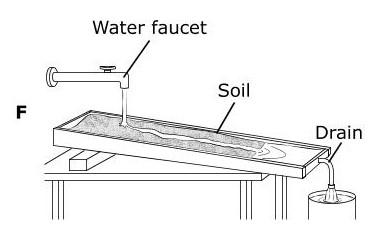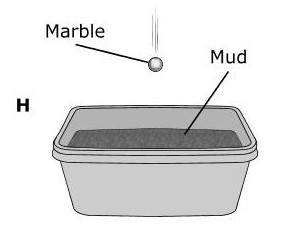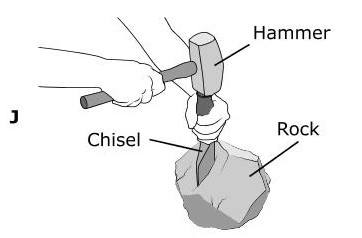
Slow and Rapid Changes
Quiz
•
Science
•
5th Grade
•
Practice Problem
•
Medium
+2
Standards-aligned

Map Munoz
Used 425+ times
FREE Resource
20 questions
Show all answers
1.
MULTIPLE CHOICE QUESTION
5 mins • 1 pt

The Rio Grande Valley is located at the southern tip of Texas at the end of a long river known as the Rio Grande. How did the delta at the end of the Rio Grande form? (5.7B)
Sand and mud from the Gulf of Mexico were washed ashore by tsunamis.
The river cut through the solid bedrock of the valley.
The river deposited large amounts of sediment from land erosion.
Hurricanes pushed soil and debris from the Gulf of Mexico onto the land.
Tags
NGSS.MS-ESS2-2
2.
MULTIPLE CHOICE QUESTION
5 mins • 1 pt

The photograph shows a canyon in northern Arizona. Which of these describes how this canyon was most likely formed? (5.7B)
Floods eroded the sandstone away from the canyon walls.
Glaciers eroded the canyon rock as they melted and moved.
Ice wedged into cracks in the rock and weathered the canyon walls.
Wind blew large rocks that smashed against the canyon walls.
Tags
NGSS.MS-ESS2-2
3.
MULTIPLE CHOICE QUESTION
5 mins • 1 pt

A wide U-shaped valley is shown in the photograph. This valley was most likely formed by-- (5.7B)
flash flooding
a glacier
a hurricane
melting snow
Tags
NGSS.MS-ESS2-2
4.
MULTIPLE CHOICE QUESTION
5 mins • 1 pt
The Grand Canyon is more than 400 km long and in some places almost 2 km deep. Which model best represents the main process that formed the Grand Canyon? (5.7B)




Tags
NGSS.MS-ESS2-2
5.
MULTIPLE CHOICE QUESTION
5 mins • 1 pt

A scientist was studying a type of event that occurred on Earth in various places within a 30-day period. The circles indicate where the events happened. The events being studied involved rapid changes to Earth's surface at the locations shown on the map. What type of event do the circles on the map most likely represent? (3.7B)
Landslides, because they are all located along ocean coastlines
Volcanoes, because they occur only near the equator
Earthquakes, because they occur on land and on the ocean floor
Floods, because heavy rains can make riverbeds deeper and create deltas
Tags
NGSS.MS-ESS2-2
6.
MULTIPLE CHOICE QUESTION
30 sec • 1 pt

Tags
NGSS.MS-ESS2-2
7.
MULTIPLE CHOICE QUESTION
30 sec • 1 pt

Tags
NGSS.MS-ESS2-2
Create a free account and access millions of resources
Create resources
Host any resource
Get auto-graded reports

Continue with Google

Continue with Email

Continue with Classlink

Continue with Clever
or continue with

Microsoft
%20(1).png)
Apple
Others
By signing up, you agree to our Terms of Service & Privacy Policy
Already have an account?
Similar Resources on Wayground

20 questions
Science in English - Chapter 6 (The earth and beyond)
Quiz
•
5th Grade

15 questions
El PLANETA TIERRA
Quiz
•
5th Grade

20 questions
Matter Matters
Quiz
•
5th Grade

20 questions
telecommunications and networks
Quiz
•
1st - 5th Grade

16 questions
leaves
Quiz
•
5th - 6th Grade

15 questions
5 Senses
Quiz
•
4th - 5th Grade

15 questions
Forces and Motion Review
Quiz
•
5th Grade

15 questions
Human Organs and Systems Quiz
Quiz
•
5th Grade
Popular Resources on Wayground

20 questions
Halloween Trivia
Quiz
•
6th - 8th Grade

25 questions
Multiplication Facts
Quiz
•
5th Grade

15 questions
Order of Operations
Quiz
•
5th Grade

20 questions
Halloween
Quiz
•
5th Grade

16 questions
Halloween
Quiz
•
3rd Grade

12 questions
It's The Great Pumpkin Charlie Brown
Quiz
•
1st - 5th Grade

20 questions
Possessive Nouns
Quiz
•
5th Grade

10 questions
Halloween Traditions and Origins
Interactive video
•
5th - 10th Grade
Discover more resources for Science

20 questions
Physical and Chemical Changes
Quiz
•
5th Grade

22 questions
Light Energy
Quiz
•
5th Grade

25 questions
CA2 Science Review
Quiz
•
3rd - 5th Grade

20 questions
NC Check in review #1
Quiz
•
5th Grade

10 questions
Producers, Consumers, and Decomposers
Quiz
•
5th Grade

20 questions
Chemical and Physical Changes
Quiz
•
5th Grade

10 questions
Law of Conservation of Mass
Quiz
•
5th Grade

13 questions
Electrical Circuits
Quiz
•
5th Grade



